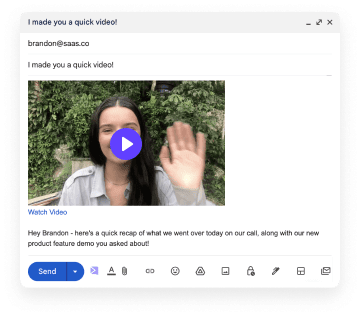Sales AI tools aren’t a trend anymore — they’re how top teams hit quota. With saturated inboxes, longer cycles, and less time for manual work, reps need leverage. AI gives it to them. From personalizing cold outreach to spotting high-intent buyers, sales teams are using AI to simplify what used to take hours.
This guide walks you through the 8 best sales AI tools to add to your stack in 2025 — with exactly what each does, why it matters, and where to try it.
Table of Contents
- What Are Sales AI Tools?
- Why Sales Teams Are Using AI in 2025
- 8 Must-Have Sales AI Tools
- How to Choose the Right Tools
- Final Thoughts
What Are Sales AI Tools?
Sales AI tools help automate or enhance your sales workflow — things like:
- Writing personalized outreach
- Researching and enriching lead data
- Qualifying buyers
- Analyzing calls
- Personalizing video
- Tracking buyer intent
Instead of replacing reps, they give reps more time to sell, automate the repetitive stuff, and help surface better opportunities.
Why Sales Teams Are Using AI in 2025
- Buyers do more research alone.
You’re no longer in control of the funnel — AI helps you spot signals early and act before your competitors. - Cold outreach is saturated.
Everyone's automating emails. The winners are using AI to personalize at scale. - Reps are stretched thin.
Whether you’re doing outbound or closing enterprise deals, AI tools reduce busywork and let you focus on conversations, not admin.
8 Must-Have Sales AI Tools for 2025
1. Sendspark
What it is: AI-powered personalized video at scale. Create branded video messages with dynamic intros and on-screen customization — all based on CRM data.
How it helps: Teams use Sendspark to warm up cold leads, re-engage stale opps, and stand out post-demo without recording every video manually.
2. Clay
What it is: Clay is a prospecting engine that combines data enrichment, scraping, and AI personalization into a single workflow. Pull lead data from 50+ sources and generate personalized messages automatically.
How it helps: SDRs build high-context outbound sequences in minutes instead of hours. Combine job changes, firmographics, and icebreakers in a single click.
🎯 Try Clay
3. ChatGPT (with Sheets plugin)
What it is: ChatGPT is your writing assistant for cold email, follow-ups, or call prep. When paired with Google Sheets, you can generate thousands of custom lines, value props, or subject lines in bulk.
How it helps: Startups and lean teams use this combo to generate email copy at scale with zero budget — great for teams without a full enablement engine.
4. Hyperbound
What it is: AI coaching platform for sales reps. It reviews your calls and demos, then provides targeted feedback on tone, pacing, objection handling, and talk tracks.
How it helps: Teams use Hyperbound to onboard reps faster, improve live conversations, and catch performance issues before they hurt pipeline.
5. Common Room
What it is: A signal detection platform that finds prospects engaging in relevant conversations across LinkedIn, Reddit, GitHub, and Slack — before they fill out a form.
How it helps: Great for uncovering in-market buyers in niche segments. Find out who’s talking about your category or problem space and reach out early.
6. Lavender
What it is: Lavender is a real-time email assistant for sales. It scores your email as you write and offers suggestions to improve tone, clarity, structure, and personalization.
How it helps: Helps reps write better emails, faster — while avoiding sounding robotic. A small shift in language can mean a big difference in reply rates.
🎯 Try Lavender
7. UserGems
What it is: Tracks when your past customers change jobs or when target personas join ICP companies — turning warm connections into new pipeline.
How it helps: Revenue teams use it to restart conversations with people who already know and trust the product.
🎯 Try UserGems
8. Warmly
What it is: Real-time website visitor tracking with AI insights. Warmly identifies anonymous visitors, suggests timing, and even offers icebreakers based on behavior.
How it helps: Great for outbound reps who want to strike while the lead is hot — not 5 days later.
🎯 Try Warmly
How to Choose the Right Tools
Here’s a quick framework to evaluate what’s worth testing:
- Does it plug into your current stack?
If it doesn’t integrate with your CRM, inbox, or outbound platform — skip it. - Will your reps actually use it weekly?
Fancy dashboards don’t matter. Look for daily-use tools with low friction. - Does it save time, not just add features?
Great AI tools don’t create more complexity. They reduce clicks, context switches, and manual work. - Does it personalize at scale?
If it sounds like a mail merge — your prospects will ignore it. Look for tools that help you speak to the individual. - Can it work without technical help?
You don’t need a data engineer to make sales tools work. Aim for tools that require <30 minutes to learn and use. - Is it solving a problem your team actually feels?
Don’t buy tools for wishlist problems. Start where your reps are stuck today — follow-up, research, outreach, or admin.
Final Thoughts
AI isn’t a silver bullet — but it’s the biggest upgrade sales has seen in a decade. You don’t need to reinvent your process. You just need to automate the parts that waste time.
Start small:
- Pick one friction point in your sales motion
- Test a tool that solves it
- Measure what happens
If you’re sending cold outreach, start with Sendspark — it’s fast to set up and can lift reply rates without rewriting your entire playbook.
Want help picking the right AI stack for your team? Just ask.
FAQs
Q: Are AI sales tools replacing sales reps?
No. They’re not replacing reps — they’re giving reps leverage. Think of them as assistants that help with research, messaging, or task automation.
Q: What’s the easiest tool to get started with?
Sendspark and Lavender both have fast setup and immediate impact. Great for improving messaging with minimal effort.
Q: Do these tools work for inbound and outbound?
Yes. Tools like Common Room and Warmly are great for inbound intent, while Clay and Sendspark are perfect for outbound workflows.
Q: How much do these tools cost?
Most of them offer free trials or low-cost starter plans. Prices vary by team size and feature depth — check their websites for details.
Q: Can I stack multiple AI tools together?
Absolutely. A common stack might look like:
- Clay for research
- Sendspark for personalized video
- Lavender for writing help
- Warmly for intent signals




